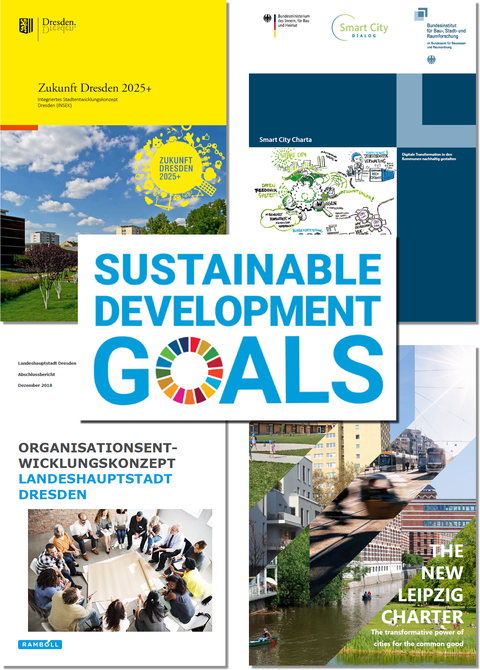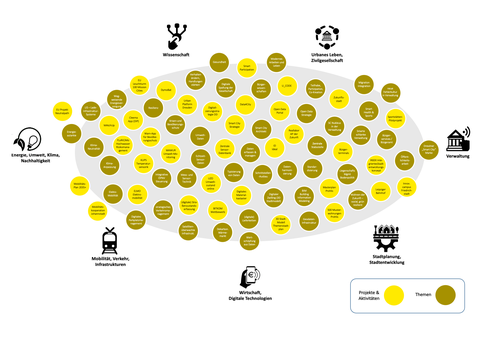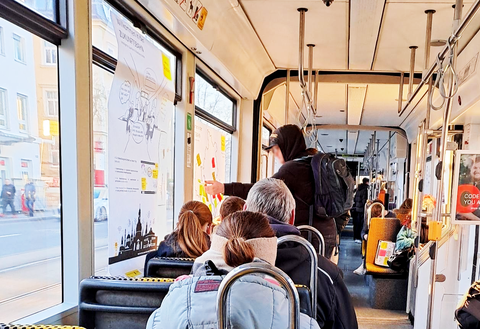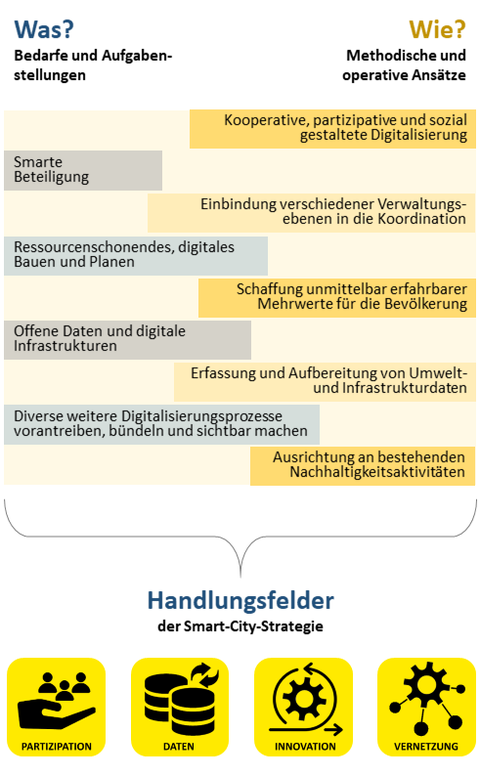Phase 1 - Smart City Strategy
Table of contents
Analysing the status quo
Strategic framework and inventory of current smart city measures
Sustainable urban development towards a smart city must be considered holistically and harmonise with existing strategy and planning documents. The WISSENSARCHITEKTUR research group therefore analysed a broad selection of guideline documents:
- Sustainable Development Goals (SDGs) of the United Nations
- Leipzig Charter for urban development for the common good in Europe
- Smart City Charter of the German Federal Government
- Digitalisation strategy of the Free State of Saxony "Sachsen Digital"
- Organisational development concept (OEK) of the state capital Dresden
- Digitisation concept ("DDi - DresdenDigital: Concept for the further development of the digitisation of the state capital Dresden")
- Integrated Urban Development Concept Dresden (INSEK)
"Smart City Radar"
The smart city-relevant projects and measures already implemented or currently running in Dresden were also analysed and integrated into the strategy process as valuable local knowledge and technology resources.
The results were summarised in a "Smart City Radar" - a tool made by WISSENSARCHITEKTUR that also can be used in further project support for synergy development as well as for monitoring the implementation measures.
Results
From the extensive project and topic maps of the Smart City Radar (which currently comprise several hundred entries) some topic clusters and anchor projects stand out that represent important cornerstones for the Smart City strategy:
- EU projects and networks such as the Horizon2020 Smart City Lighthouse project MAtchUP or the 100 Climate Neutral and Smart Cities programme
- Mobility concepts of the city such as the development of the Mobility Plan 2035+
-
Innovations in the health sector, such as the Smart Health Innovation Campus or the intelligent utilisation management of sports facilities in the Ostragehege park
- Projects on sustainable construction, resource and energy efficiency such as Heat Resilient Cities, InKliBau and the establishment of intelligent home stations, some of which are being implemented with housing associations
- The sensor-based recording of environmental and infrastructure conditions in projects such as Umweltzustand online, WAWUR, Photogrammetrische Straßenzustandserfassung, or KLIPS as a basis for intelligent citizen services, urban and operational planning and as input for Dresden's geodata infrastructure and 3D city model
-
The Open Data Portal as a central point for the comprehensive provision of environmental and geodata as well as other specialised data sets (e.g. population, education, economy and work)
-
New local service infrastructures, e.g. in the form of neighbourhood-compatible citizen terminals / service hubs or micro-depots that also function as social meeting and community spaces
- Service apps and online services such as online ticketing for car parks, the defect detector, the warning app or the Cleema app established during the strategy phase of the model project
Participation process for the stakeholder groups
Important conceptual foundations for the strategy were developed through participation processes. A participatory needs and problem analysis, in which all stakeholder groups were involved, ensured the formulation, reflection and qualification of the future strategic vision in its empirical breadth and at the same time made it possible to identify potential risks and existing fears.
Workshops with experts
In a vision workshop, pioneering ideas and visions for Dresden's smart city strategy were developed on the basis of the entries collected in the Smart City Radar. In a roadmapping workshop, initial anchor points for implementation and action plans were outlined for the ideas and visions developed. From autumn 2022, further stakeholders from business, science and administration were involved in the strategy process in several reflection workshops.
Online survey and "Future Tram"
An online survey was conducted to gather the opinions of the Dresden population on the proposed ideas and to incorporate the perspective of the wider public into the strategy process. More than 600 participants gave their opinions on the proposed visions, the methods and tools of strategy development, possible opportunities and risks and further developed the results of the vision workshops.
In Dresden, citizens were able to take part in public participation events organised by the "Future Tram". Here, three regularly running trams became rolling idea laboratories in which passengers could contribute their thoughts on Smart City Dresden "on the move". The ideas and comments were recorded directly in the tram and presented on posters.
The advantage is that people with little affinity for digital media could also be involved in the conceptual work. Overall, a cross-section of the population was reached and effectively made aware of the model project.
The focus of the survey was on relevant topics of neighbourhood development and district design, e.g. sustainability, social justice and digitalisation.
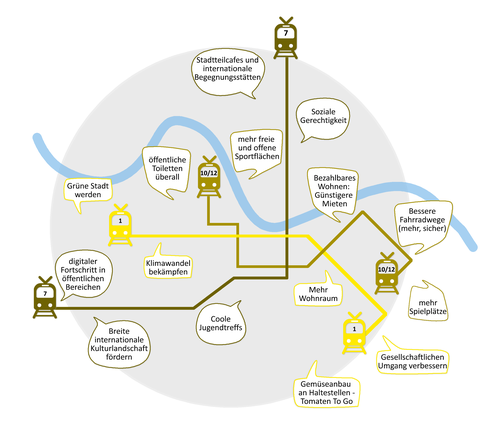
Themencluster aus den Beteiligungsveranstaltungen der "Zukunftsbahn" (zum Vergrößern bitte klicken)
Results
All the basic principles, needs and challenges recorded, as well as the overarching guidelines, were brought together in a comprehensive synthesis process and organised into 4 thematic blocks.
- Resource-saving, digital planning and construction: Planning and construction processes are to be digitalised and the topic of "Smart City" docked in the urban planning office. Climate neutrality by 2035 and adaptation to climate change will be key topics for construction, urban planning and redevelopment.
- Open data and digital infrastructures: Open source software solutions and open data will be further developed as basic digital infrastructures and strategic tools for urban planning and development and made available to the administration and the public.
- Smart participation: In order to promote participatory and user-oriented neighbourhood development, low-threshold, representative and standardised participation opportunities for citizens need to be established and linked more closely with administrative processes.
- Synthesize digitalisation processes and make them visible: In order to further advance digitalisation in Dresden, an active nucleus for smart city activities must be established in the administration in order to bring about sustainable changes in behaviour. In addition, digital approaches for modern working and resource savings should be utilised and data-based added value created with benefits for the city as a whole.
The collected topics and objectives even go beyond the concrete scope of the model project in terms of their breadth and complexity and give a comprehensive image of the current challenges in Dresden, which the Smart City strategy and other future Smart City activities should be geared towards.
Methods and tools for strategy development
For the development of the Dresden Smart City strategy, a process was designed that combines elements of innovation and participation research as well as IT and software development.
Double Diamond, Agility, Quadruple Helix
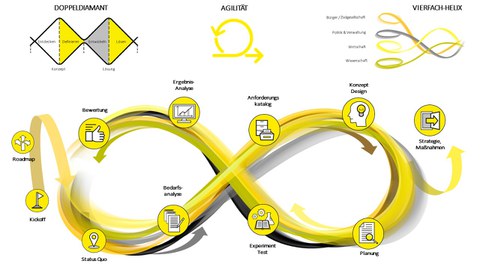
Schema der Methodenkombination für die Strategieentwicklung (zum Vergrößern bitte klicken)
- The double diamond from design thinking is a creativity process that leads from problem definition to idea development to prototyping in a targeted manner through successive divergence and convergence phases.
- The principle of agility in IT and software development describes a step-by-step, iterative approach in which requirements and solutions are flexibly adapted in dialogue between developers and customers in order to be able to react quickly to changes.
- The quadruple helix from innovation and participation research supports cooperation between four stakeholder groups - politics/administration, civil society, business and science - in order to make innovations economically, socially and ecologically sustainable.
With these foundations, the strategy was developed in creative dialogue with the various participation groups to ensure that a wide range of needs are taken into account. In particular, the pragmatic aspects of the strategy and its implementation were analysed with the various stakeholder groups. In this way, the perspective of those directly affected was documented, benefit-orientated requirements were incorporated into the innovation process and user knowledge was directly strengthened.
Results
The pioneering ideas that emerged from the participation formats were consolidated into strategic approaches in the further development process. The various approaches were compared and summarised in order to consolidate them into an overarching smart city vision - whereby particular care was taken to take into account the diversity of the individual approaches and to carry them forward.
The strategic vision for Dresden as a smart city was formulated in this guiding principle:
Creating new resources for a socially just and climate-neutral Dresden - through experimental participatory urban development, digital urban infrastructures and communicative administration!
With this objective, Dresden as a smart city should above all create new resources and enable substantial gains in time, information, knowledge, health and energy for its citizens - which they can use for the common good. The smart city strategy thus becomes a socially and administratively anchored urban innovation process.
The following fields of action for the model project were derived from the strategic vision and the participatory stocktaking:
- Participatory problem analysis and resource creation goals
- Collecting, organising and continuously providing data
- Implementing, testing and evaluating innovations on a model basis
- Stabilisation through new innovation ecosystems in Dresden and supra-regional networking
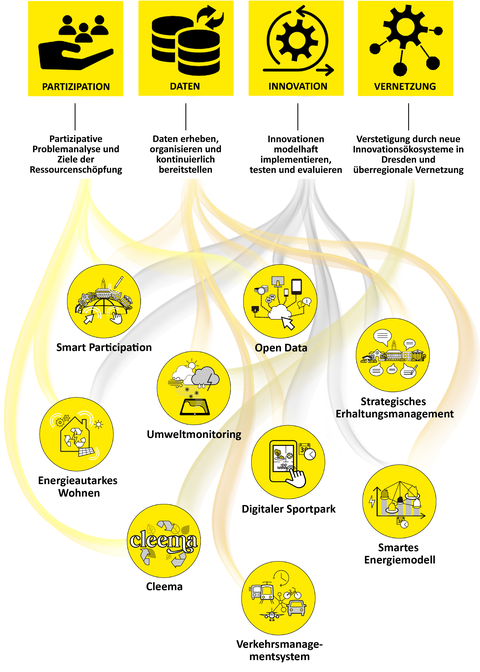
Handlungsfelder und Maßnahmen und des Modellprojekts (zum Vergrößern bitte klicken)
Based on the fields of action, the smart measures were developed. In the implementation phase, the model districts ("Intelligent Quarters") are understood as digital test fields for the Smart City project, in which intelligent solutions are designed and tested on a pilot basis.
The quarters Friedrichstadt, Johannstadt and Dresden Ost/Prohlis are in this sense representative of Dresden as a whole. The strategy is therefore aimed at all city districts in which successfully tested innovations from the above-mentioned pilot neighbourhoods are replicated and can also be used in the future.

